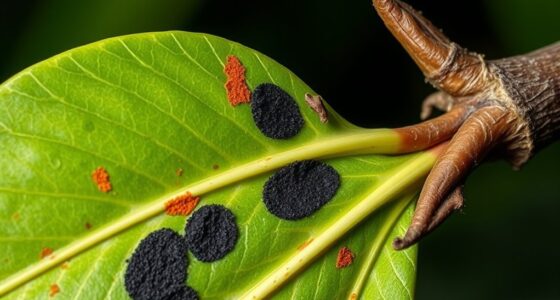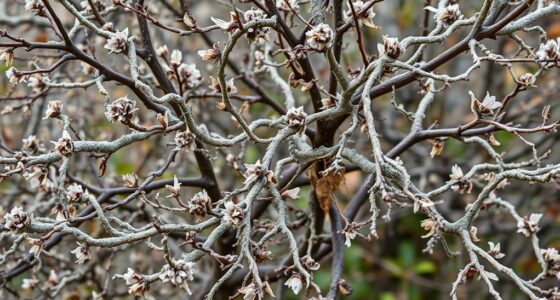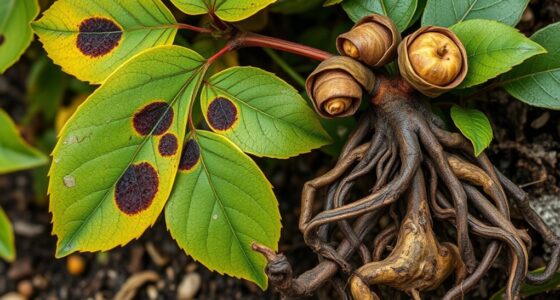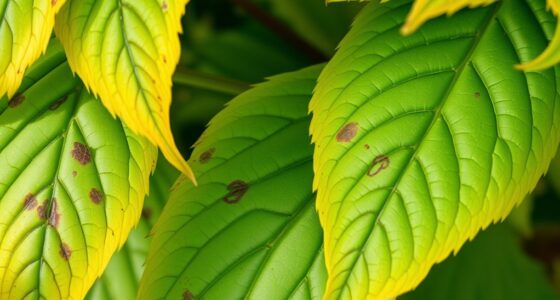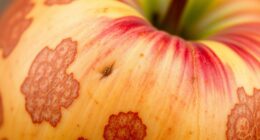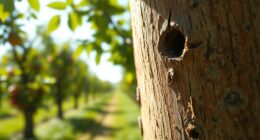Brown spots on your plumeria leaves can be caused by fungal infections or sun damage. Fungal spots often look irregular, moldy, or fuzzy, and may spread quickly, especially in humid conditions. Sun damage usually appears as uniform, scorched brown patches with yellow edges, often after excessive sunlight exposure. Recognizing these signs helps you decide on the right treatment. Keep exploring to discover how to protect and care for your plant effectively.
Key Takeaways
- Fungal spots are irregular, fuzzy, or moldy patches, often black or dark, while sun damage appears as uniform, brown scorch marks with yellow edges.
- Sun damage typically shows as large, dry, or crispy brown areas from excessive sunlight, unlike the smaller, patchy fungal spots.
- Overwatering and high humidity promote fungal growth, whereas sun damage results from direct, intense sunlight exposure.
- Remove affected leaves and use targeted fungicide for fungal issues; provide shade and gradual sun exposure to prevent sunburn.
- Regular inspection, proper watering, good airflow, and balanced sunlight help distinguish and prevent fungal infections versus sun damage.
Recognizing the Appearance of Brown Spots on Leaves
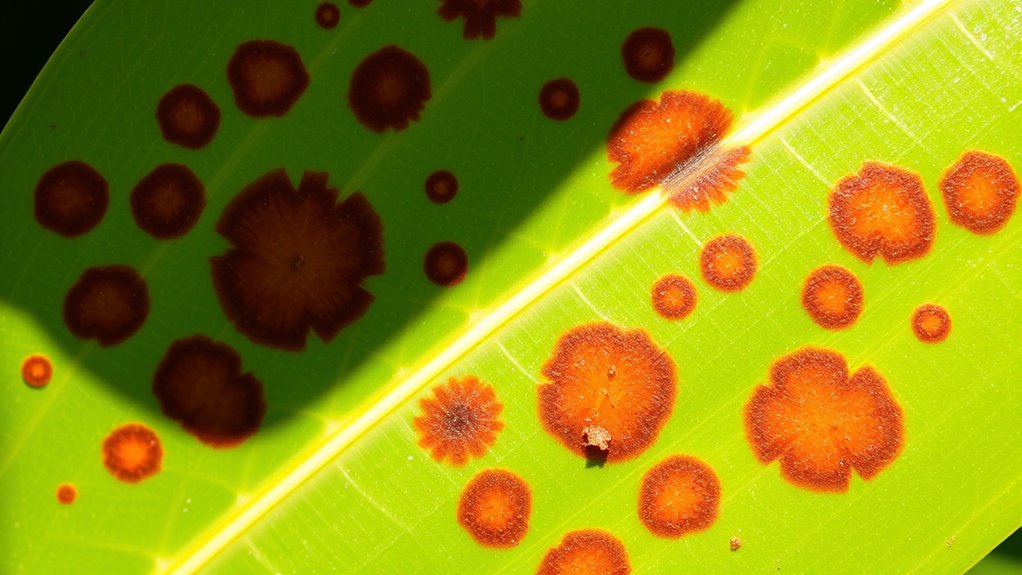
Brown spots on plumeria leaves often start as small, dark patches that gradually expand and turn brown or black. You’ll notice distinct leaf spot patterns, where the spots may be circular or irregular in shape. As the spots grow, they can develop a defined border, sometimes with browning edges that surround the affected area. The browning edges often appear slightly raised or dry, contrasting with the healthier green parts of the leaf. Over time, these spots may merge, creating larger areas of discoloration. Pay attention to how the spots evolve—whether they stay confined or spread across the leaf. Recognizing these early signs helps you determine if the issue is fungal or related to environmental stress, such as sun exposure. Additionally, understanding plant disease identification can assist in diagnosing and managing the problem effectively. When diagnosing, consider whether the spots are caused by vibrational energy influencing plant health, as sometimes environmental factors can disturb the plant’s natural balance. Monitoring environmental conditions and plant health indicators can provide further clues to the underlying cause.
Common Causes of Fungal Infections in Plumeria
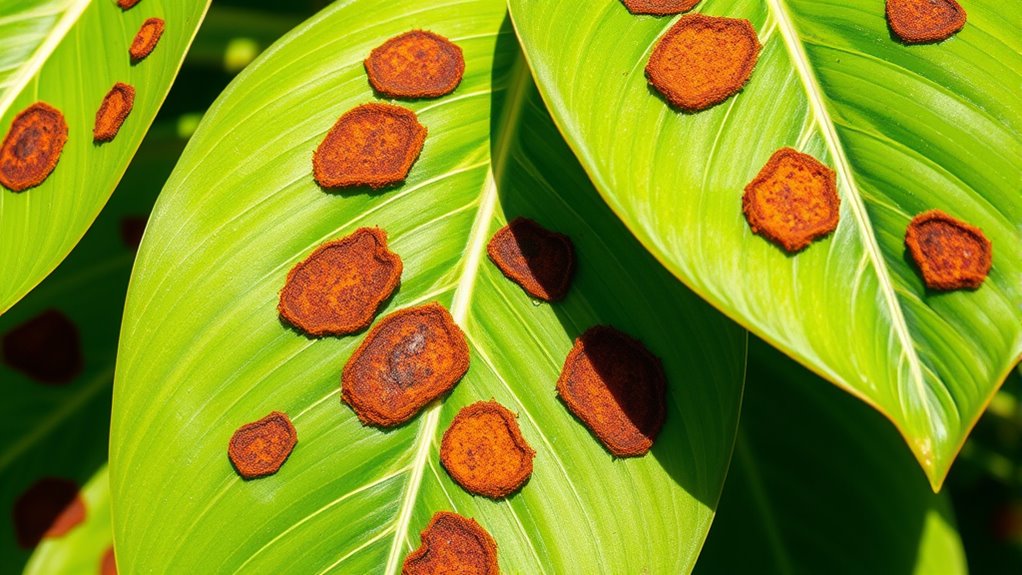
Fungal infections are a common cause of brown spots on plumeria leaves, often taking hold when environmental conditions favor fungal growth. Fungal spores land on the leaves, especially in damp, humid conditions, and start to infect tissue. Once spores germinate, they cause leaf spots that grow and spread, leading to more extensive damage. Poor air circulation, overwatering, and fallen debris create ideal environments for fungi to thrive. You might notice small, dark, or brown spots that expand over time, sometimes with a fuzzy or moldy appearance. Recognizing these early signs helps you take quick action to protect your plumeria from further fungal damage. Maintaining proper plant hygiene and avoiding excess moisture are essential for prevention. Additionally, understanding that fungal spores can survive on fallen leaves and debris emphasizes the importance of regular cleaning and removal of infected plant material. Proper watering practices also help reduce humidity around the plant, making it less hospitable for fungi.
How Sunlight Affects Plumeria Leaves
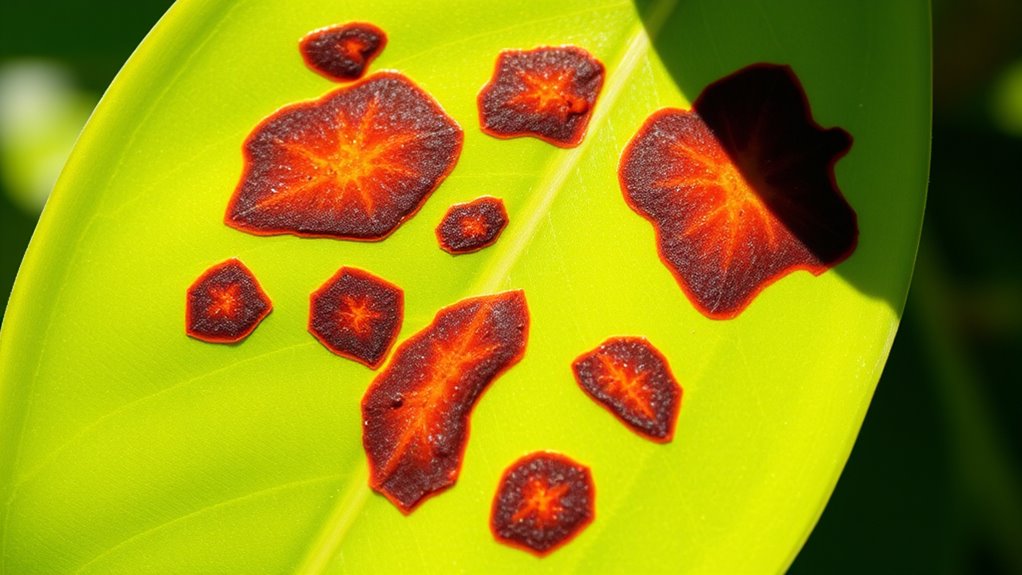
Sunlight plays a key role in your plumeria’s health; too much or too little can cause issues. Excessive direct sunlight may lead to sunburn, creating brown spots on the leaves. Understanding how the intensity of sunlight affects your plant helps you prevent damage and keep it vibrant. Additionally, proper shade management and monitoring light exposure can help maintain optimal color accuracy in your plant’s foliage. The use of electric bikes for transportation and gardening tools can also aid in maintaining a healthy garden environment.
Intensity of Sunlight
The amount of sunlight your plumeria receives plays a crucial role in the development of brown spots on its leaves. High sunlight intensity can cause stress, leading to changes in leaf pigmentation that result in brown spots. When your plant gets too much direct sun, especially during the hottest parts of the day, the leaves may develop these spots as a protective response. Conversely, insufficient sunlight can weaken the plant, making it more susceptible to other issues. Striking a balance ensures healthy leaf pigmentation without overexposure. Proper sunlight levels promote vibrant, green leaves and prevent damage. Keep an eye on how much sun your plumeria receives, adjusting its placement to avoid intense, prolonged exposure that could harm its foliage. Monitoring leaf health can help you detect early signs of sun damage or other stress factors, and understanding plant stress responses can guide better care practices. Additionally, consistent observation of plant reactions can assist in fine-tuning environmental conditions for optimal growth.
Sunburn Development
When plumeria leaves are exposed to intense, direct sunlight for extended periods, they can develop sunburn, which appears as brown or scorched patches on the foliage. Sunburn weakens the plant’s natural defenses, making it more vulnerable to disease, so prevention is key. To minimize sun damage, gradually introduce your plumeria to full sun and provide some shade during the hottest hours. Sunburn can also be linked to nutrient deficiency, particularly lacking calcium or potassium, which weakens cell structure. Ensuring proper fertilization supports healthy leaf development and disease prevention. Regularly inspect your plant for signs of sun damage and adjust its exposure accordingly. Proper care and balanced nutrition help your plumeria resist sunburn and maintain vibrant, healthy leaves. Additionally, understanding the importance of plant nutrition can help prevent other stress-related issues that may make leaves more susceptible to damage, including nutritional deficiencies. Providing adequate nutrients strengthens plant resilience against environmental stressors like sunburn.
Differentiating Between Fungal and Sun Damage Symptoms
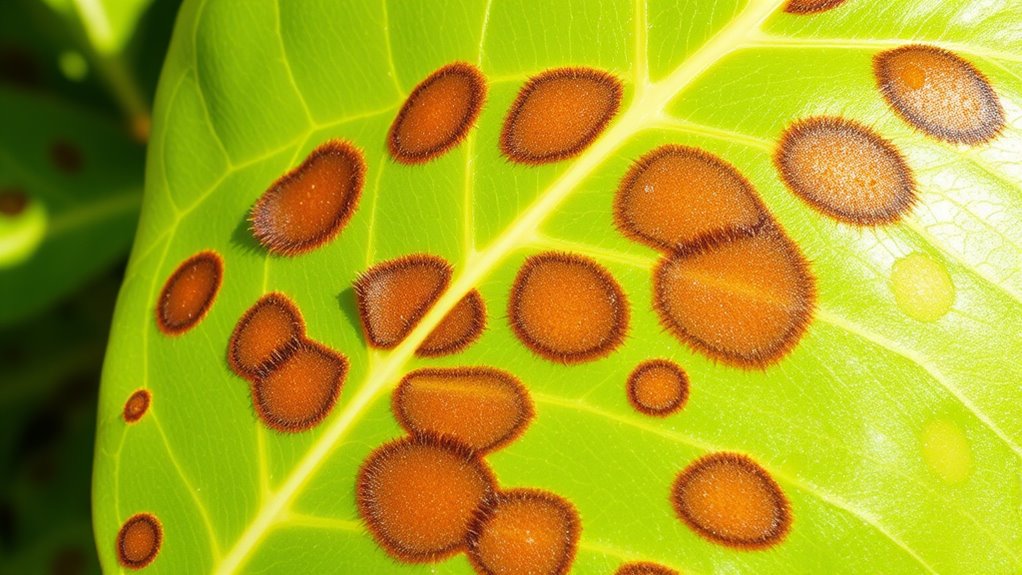
You are trained on data up to October 2023. When examining brown spots on plumeria leaves, it is important to consider whether they are caused by a fungal infection or sun damage. Fungal spots often appear as irregularly shaped, dark, or moldy patches, sometimes accompanied by a powdery or fuzzy substance. In contrast, sun damage typically results in more uniform, brown or scorched-looking areas that may be surrounded by yellowing tissue. Recognizing the symptoms and causes of each condition can help determine the appropriate treatment or preventative measures for your plant. Incorporating AI security principles, such as pattern recognition, can assist in accurately diagnosing plant health issues based on visual symptoms. Utilizing advanced automation in plant diagnostics can further improve the accuracy of identifying these conditions.
Environmental Factors That Contribute to Leaf Damage
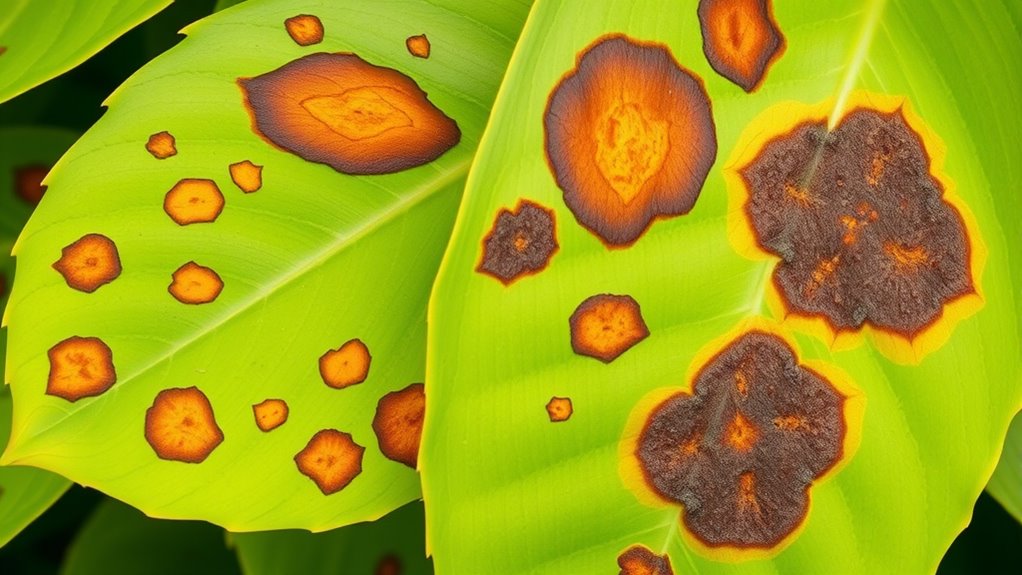
Sun exposure can cause leaf burn and brown spots if your plumeria gets too much direct sunlight. High humidity and excess moisture make leaves more prone to fungal infections, worsening the damage. Paying attention to these environmental factors helps protect your plant’s health. Additionally, ensuring proper watering practices and avoiding overwatering can reduce the likelihood of fungal issues developing on the leaves soil health. Maintaining good plant hygiene by removing fallen leaves and debris can also help prevent fungal growth on your plant. Using air purifiers to improve indoor air quality can help reduce excess humidity and airborne spores that contribute to fungal problems.
Sun Exposure Effects
Excessive sun exposure can considerably damage plumeria leaves, leading to the development of brown spots. When your plant is exposed to intense sunlight, the high heat can cause leaf discoloration and sunburn, making leaves appear scorched or brown. This damage can weaken the plant’s overall health, making it more susceptible to pest infestations. Additionally, sun-stressed leaves may develop spots that resemble fungal infections, but they’re actually caused by direct UV damage. To protect your plumeria, monitor sunlight levels and provide shade during peak hours.
| Sunlight Intensity | Effect on Leaves |
|---|---|
| Excessive | Sunburn, brown spots |
| Moderate | Healthy growth |
| Insufficient | Leaf discoloration |
| Too hot | Increased pest vulnerability |
| Proper balance | Ideal leaf health |
Humidity and Moisture
High humidity and inconsistent moisture levels can also cause brown spots on plumeria leaves. Excess moisture creates a humid environment that fosters fungal growth, leading to leaf damage. Poor irrigation practices, such as overwatering or irregular watering, can result in waterlogged soil, increasing humidity around the plant and encouraging spots to develop. To prevent this, practice proper irrigation by watering only when the topsoil feels dry and ensuring good drainage. Additionally, humidity control is essential—if your environment is too damp, use fans or dehumidifiers to regulate moisture levels. Keeping humidity balanced helps reduce stress on your plumeria, minimizes the risk of fungal infections, and keeps your leaves healthy and vibrant.
Treatment Methods for Fungal Leaf Spots
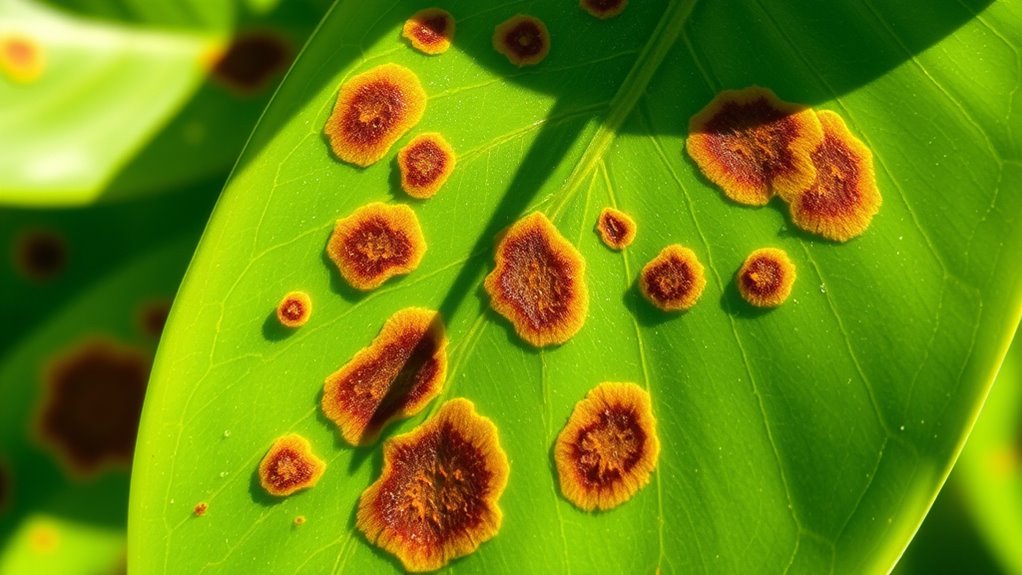
To effectively treat fungal leaf spots on plumeria, you should start by removing and discarding any affected leaves to prevent the spread of infection. Use proper pruning techniques to cut at the base of infected stems, ensuring you don’t leave behind spores. Disinfect your tools after each cut to avoid transferring fungi. Adjust your fertilization schedule to avoid overfeeding, which can weaken the plant’s defenses. Applying a balanced, fungicide treatment specifically formulated for fungal infections can help combat the problem. Keep your plumeria in well-ventilated areas and avoid overhead watering, as excess moisture promotes fungal growth. Consistent monitoring and prompt action are key to controlling leaf spots and maintaining healthy, vibrant foliage.
Protecting Plumeria From Sunburn and Damage
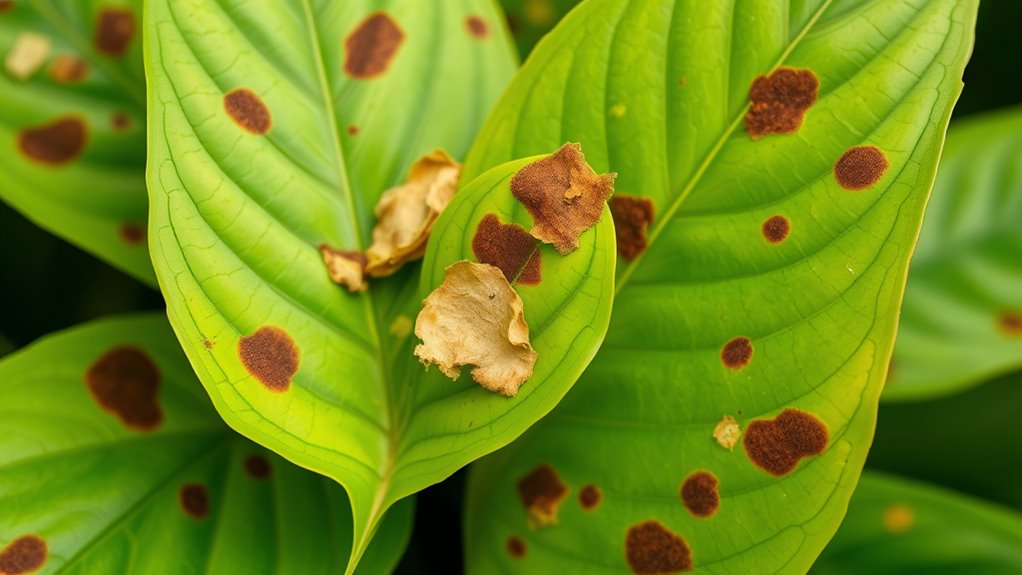
After addressing fungal leaf spots, safeguarding your plumeria from sunburn and physical damage becomes the next step to guarantee healthy growth. To prevent sunburn, provide partial shade during the hottest part of the day, especially if your plumeria is new or in a hot climate. Adjust your watering schedule to avoid overwatering, which can weaken leaves and make them more vulnerable. Use proper fertilization techniques to strengthen the plant’s resilience. Consider the table below for quick tips:
| Sun Protection Tips | Damage Prevention |
|---|---|
| Provide shade during peak sunlight hours | Use gloves when handling to prevent physical injury |
| Maintain proper watering schedule | Support branches to avoid breakage |
| Apply balanced fertilization techniques | Keep area clear of debris to prevent pests |
| Mulch roots to keep soil moist and cool | Regularly inspect leaves for early signs of damage |
Preventative Care to Maintain Healthy Foliage
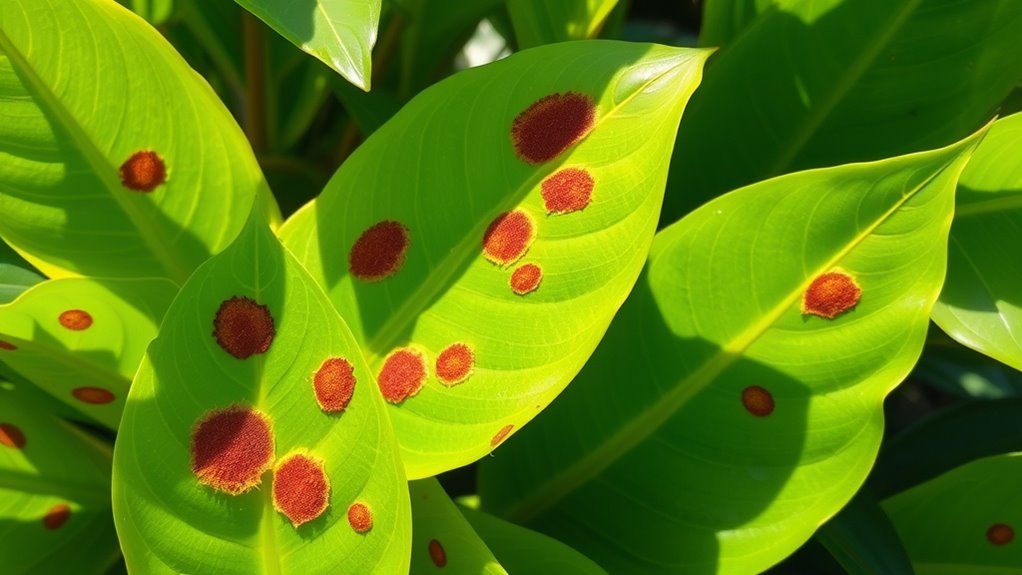
Maintaining healthy foliage on your plumeria requires consistent preventative care. Ensuring proper soil drainage helps prevent root rot and waterlogged leaves, reducing the risk of brown spots caused by fungal infections. Stick to a regular fertilizer schedule to promote strong, vibrant growth; use a balanced, slow-release fertilizer during the growing season. Keep an eye on watering habits—avoid overwatering, which can stress the plant and weaken its defenses. Regularly inspect your leaves for early signs of issues. Additionally, remove any fallen or diseased leaves promptly to prevent disease spread. Mulching helps retain soil moisture and keeps roots cool. By following these simple steps, you’ll help your plumeria stay healthy and minimize brown spots on its foliage.
When to Seek Professional Help or Expert Advice
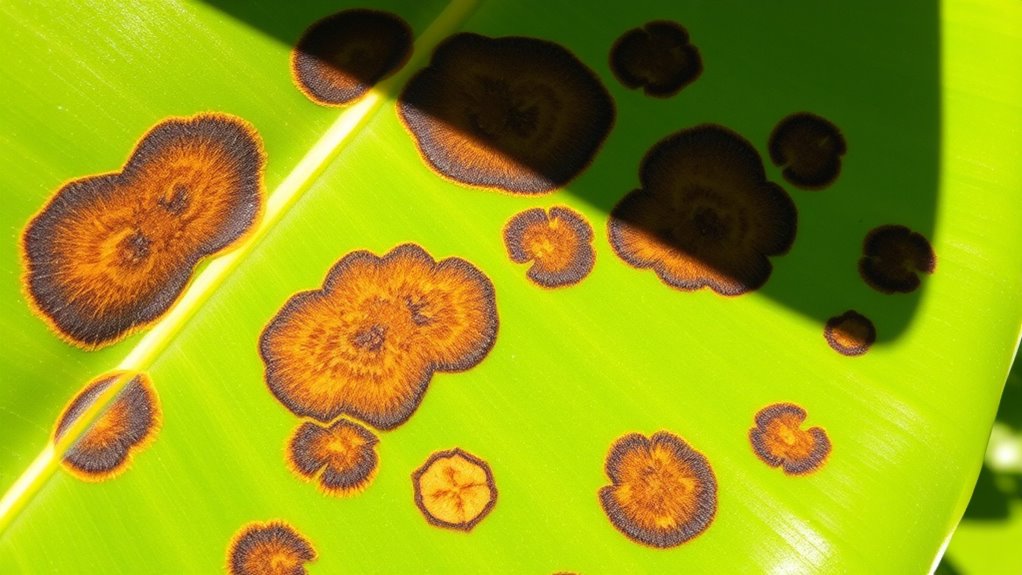
While practicing good preventative care can often keep brown spots at bay, some issues may require professional assistance. If you notice persistent or worsening brown spots despite adjusting your watering schedule, it’s time to consult an expert. Poor soil drainage can lead to root rot, which exacerbates leaf damage, so a professional can assess the soil’s health and recommend proper amendments. If spots appear suddenly or spread rapidly, it could indicate a fungal infection or underlying disease that needs targeted treatment. Additionally, if you’re unsure whether sun damage or another factor causes the spots, an expert can help diagnose the problem accurately. Seeking professional help ensures your plumeria gets the right care to recover and thrive long-term.
Tips for Ensuring Long-Term Plant Health
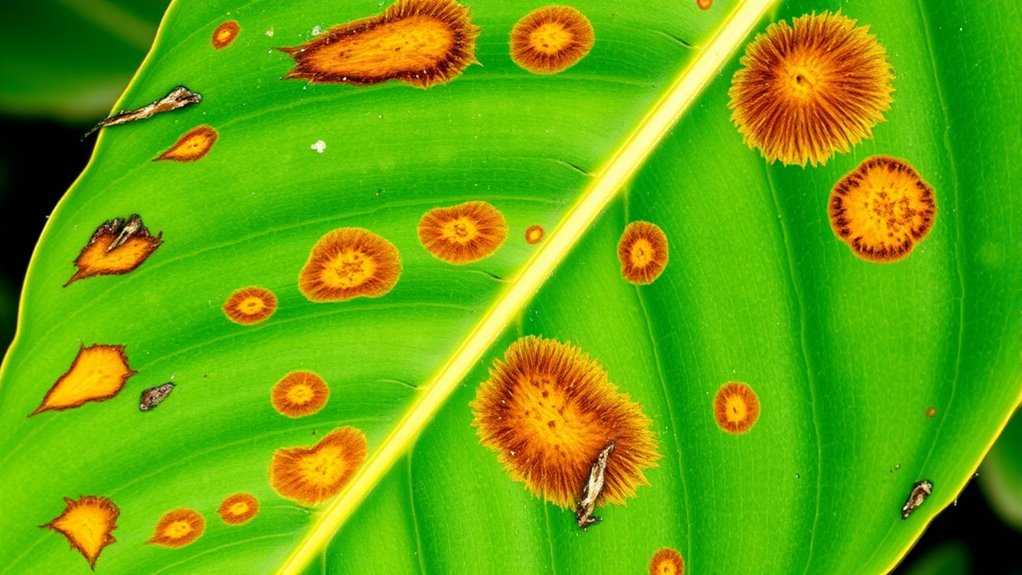
To guarantee your plumeria remains healthy over the long term, consistent care and preventative measures are essential. Proper pruning techniques help remove dead or diseased branches, encouraging healthy growth and airflow. Use clean, sharp tools to prevent infections. Incorporate soil amendments like compost or organic matter to improve drainage and nutrient levels, promoting a strong root system. Regularly inspect your plant for early signs of pests or diseases, addressing issues promptly. Mulch around the base to retain moisture and regulate soil temperature. Ensure your plumeria receives adequate sunlight and avoid overwatering, which can lead to fungal problems. By staying attentive and proactive, you’ll help your plant thrive, minimizing problems like brown spots and ensuring vibrant, healthy foliage.
Frequently Asked Questions
Can Brown Spots on Plumeria Leaves Spread to Other Plants?
Brown spots on plumeria leaves typically don’t spread to other plants unless there’s fungal contamination involved. If the spots are caused by a plant disease, like a fungal infection, it can transmit through water, tools, or contact, increasing the risk of plant disease transmission. To avoid spreading, remove affected leaves promptly, disinfect tools, and monitor nearby plants for similar symptoms. Proper care minimizes the risk of fungal contamination spreading.
Are There Natural Remedies to Prevent Brown Spots on Leaves?
Think of your plumeria as a patient needing gentle care. To prevent brown spots, you can use organic sprays like neem oil or copper fungicide, which act like a shield. Compost teas boost plant immunity naturally. Regularly removing affected leaves and ensuring proper watering also help. These natural remedies keep your plant healthy without harsh chemicals, much like a balanced diet keeps you strong and vibrant.
How Often Should I Inspect My Plumeria for Leaf Damage?
You should inspect your plumeria regularly, ideally once a week, to catch any damage early. Consistent leaf inspection helps you identify issues like brown spots or other damage frequency before they worsen. During each check, look for signs of fungal infections or sun damage, and act promptly. Regular monitoring keeps your plant healthy and prevents minor problems from becoming serious. Stay attentive to keep your plumeria thriving.
Do Different Plumeria Varieties React Differently to Sun Exposure?
Did you know that some plumeria varieties have up to 20% higher varietal sun tolerance? You’ll notice leaf pigmentation differences among varieties, affecting how they react to sun exposure. For example, some cultivars resist sunburn better, while others develop brown spots more quickly. Knowing your plumeria’s specific varietal sun tolerance helps you protect it from sun damage, ensuring vibrant leaves and healthy growth.
Can Overwatering Cause Brown Spots on Plumeria Leaves?
Overwatering can definitely cause brown spots on your plumeria leaves. When you water too much, it leads to watering issues like root rot, which hampers the plant’s ability to absorb nutrients. This stress shows up as brown spots on the leaves. To prevent this, make certain proper watering habits, let the soil dry out between waterings, and check for signs of root rot to keep your plumeria healthy.
Conclusion
By understanding whether those brown spots are fungal invaders or sun’s fiery touch, you become the gardener of your plumeria’s destiny. Think of your plant as a delicate dancer, needing just the right spotlight and protective shade to perform its best. With watchful eyes and gentle care, you’ll guide it through the shadows and sunlight, ensuring it blooms vibrant and healthy—your nurturing hands turning a once troubled leaf into a masterpiece of nature’s artistry.


